3.2 GENERAL BACKGROUND
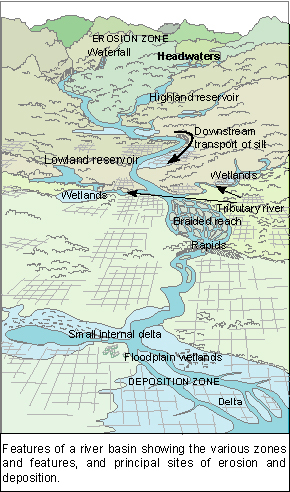 Rivers
are natural systems that carry precipitation falling on the land to areas
lower in altitude, usually the sea. Precipitation can be rainfall on lowland
areas or originate as snow in high mountains.
Rivers
are natural systems that carry precipitation falling on the land to areas
lower in altitude, usually the sea. Precipitation can be rainfall on lowland
areas or originate as snow in high mountains.
Energy is dissipated during the movement of water from higher to lower
altitudes. This energy allows water to perform a number of actions that
are expressed mainly as the erosion and deposition of sediment.
Erosion occurs when water picks up sediment from the surrounding landscape,
the riverbank or the river bottom. Deposition occurs when water drops
sediment on the river bottom or on the river lowlands during floods.
The erosion-deposition cycle depends on the physical performance of water
interacting with different sizes of particle.
The capacity of water to pick-up and transport particles is related to
the speed of the current. At any particular speed water can carry only
a determined amount of sediment of a particular size. In other words,
eventually the water becomes saturated with sediment to a point where
it can carry no more. Thus, when the water has no suspended sediment,
it can pick it up from the surrounding rocks and from the bottom through
the process of erosion, but when the water is laden with sediment it can
drop the sediment through the process of deposition.
Particles sort according to the current of the water carrying them: the
faster the current the larger the particles that can be carried. The slower
the current, the higher chance that it can carry only the smallest of
particles.
Not all material transported by the river is suspended in the water column.
Larger particles, even large boulders, can be rolled along the bottom
during the heavier floods and found at surprising distances downstream.
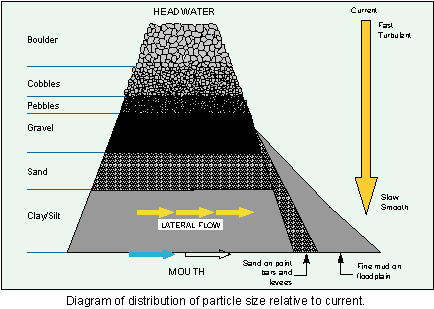 |
Suspended matter consists of
inorganic particles of sand, silt or clay that combine with organic material
that is, the remains of living matter, and that are progressively broken
down by organisms (see River Continuum Concept). The organic material
can be carried downstream freely or adhering to the particles. It may
be deposited in the bottom sediments where it may be stored for a period
of time, or it may be ingested by a living organism. The process of successive
transport and storage is known as "nutrient spiralling" and
some authors have used spiralling times as an indicator of the biological
efficiency of a river.
The underlying form of all rivers arises from the combination of the physical
need for water to dissipate its energy and from the erosion-deposition
processes.
These processes can follow an idealised pathway, but in most systems local
accidents of geology cause real rivers to deviate from the idealised condition.
Because rainfall is seasonal in most parts of the world (see section on
hydrology) any river exists in two forms, a dry season form where it is
confined to its main channel and a wet season (flood) form where it covers
adjacent land known as the floodplain.
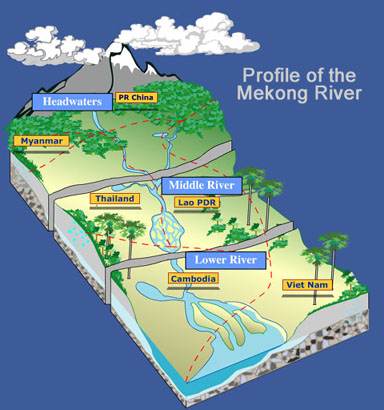 |
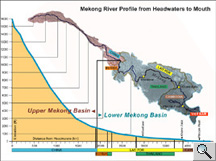 The longitudinal profile of a river is ideally
a smooth curve that is steep in its earlier course and increasingly shallow
as it moves towards the sea. This arises from the form of the landscape
where small streams are usually in upland regions and the larger rivers
in the coastal plain.
The longitudinal profile of a river is ideally
a smooth curve that is steep in its earlier course and increasingly shallow
as it moves towards the sea. This arises from the form of the landscape
where small streams are usually in upland regions and the larger rivers
in the coastal plain.
In reality, rivers rarely follow the ideal form and are forced by geographic
accidents into a more irregular profile. Outcrops of hard rock can case
erosion to be slower than normal. In some areas, one river may "capture
another", producing a change in direction and profile. For example,
the Mekong was probably once directly connected to the Chao Phraya River
of Thailand in earlier geological time.
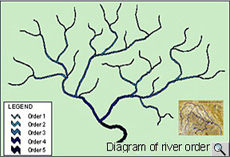 Seen
from above, a river has a tree like pattern with many small streams feeding
into fewer larger rivers and eventually into one very large river. This
type of distribution is known as a hierarchy and several systems have
been used to classify the different elements of the pattern. Some systems
depend on assigning an order to the various streams. For example the system
devised by Strahler assigns an order 1 to the smallest streams. Two order
1 streams combine to form a stream of order 2. Order 3 streams are formed
where two order 2 streams combine and so on up to order 10-12, which is
the order corresponding to the main channels of large world rivers. Individual
streams get wider and longer as stream order increases.
Seen
from above, a river has a tree like pattern with many small streams feeding
into fewer larger rivers and eventually into one very large river. This
type of distribution is known as a hierarchy and several systems have
been used to classify the different elements of the pattern. Some systems
depend on assigning an order to the various streams. For example the system
devised by Strahler assigns an order 1 to the smallest streams. Two order
1 streams combine to form a stream of order 2. Order 3 streams are formed
where two order 2 streams combine and so on up to order 10-12, which is
the order corresponding to the main channels of large world rivers. Individual
streams get wider and longer as stream order increases.